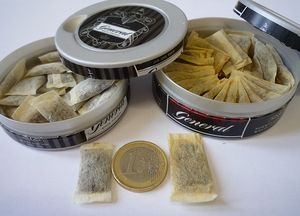Snus

Snus is a traditional Scandinavian Smokeless Tobacco product, used particularly in Sweden, where it is widely used by men and has been regulated as a food product under the Swedish Food Act since the 1970s.[1] Snus is available loose or portioned (in pouches resembling tiny tea bags), and consumed by placing the pouch or a pinch between the gum and upper lip for a period of time.
Unlike other smokeless tobacco, snus has a relatively high nicotine delivery and absorption, and relatively lower levels of harmful substances.[2] The lower levels of toxins are generally attributed to how it is manufactured and stored.[3] Although it is generally accepted that the health hazards of using snus are much less than for smoking, uncertainties about the long-term impacts remain. Studies have shown associations between snus use and pancreatic cancer, and linked snus use to type 2 diabetes, fatal heart attacks, heightened blood pressure, and preterm birth and stillbirths.[4][5][6][7][8]
Public health interest in snus began following observations of the so-called ‘Swedish Experience’, which attributes Sweden’s low smoking prevalence, and resulting low occurrence of smoking related diseases, to high rates of snus use among Swedish men. With the evidence that snus is considerably less harmful than smoking[2], and that smokers smoke because they are addicted to the nicotine (and as mentioned above snus has a relatively high nicotine delivery and absorption), this raises the potential for lives to be saved if smokers could switch to using nicotine in a less hazardous form than a cigarette.[9][10][3]
From 2002, large Tobacco Companies increasingly invested in snus. For more information on these investments, click here.
The European ban on snus sales has been repeatedly legally challenged by the industry, and a strong lobby from Sweden. Meanwhile, a peer-reviewed study found there was relatively little control on promotions and illegal snus sales via the Internet.[11]
TobaccoTactics Resources
- European market leader: Swedish Match
- Cigarette Companies Investing in Snus
- Snus: EU Ban on Snus Sales
- Snus: Marketing to Youth
- Pro-snus bloggers: Tim Haigh, Lars-Erik Rutqvist
- Smokeless Tobacco
- Harm Reduction
- A list of pages in the category Snus
TCRG Research
- Transnational Tobacco Company Interests in Smokeless Tobacco in Europe: Analysis of Internal Industry Documents and Contemporary Industry Materials, S. Peeters, A.B. Gilmore, PLoS Medicine, 2013; 10(9):1001506
- How online sales and promotion of snus contravenes current European Union legislation, S. Peeters, A.B. Gilmore, Tobacco Control, 2013; 22:266-273
Notes
- ↑ Swedish Food Regulations, Food Act (Livsmedelslagen SFS 2006:804). 2006
- ↑ 2.0 2.1 Royal College of Physicians. Harm reduction in nicotine addiction: helping people who can't quit. A report by the Tobacco Advisory Group of the Royal College of Physicians. 2007, RCP: London
- ↑ 3.0 3.1 J. Foulds, L. Ramstrom, M. Burke, et al. Effect of smokeless tobacco (snus) on smoking and public health in Sweden. Tobacco Control, 2003. 12(4), p. 349-359.
- ↑ J. Luo , W. Ye, K. Zendehdel, et al., Oral use of Swedish moist snuff (snus) and risk for cancer of the mouth, lung, and pancreas in male construction workers: a retrospective cohort study. Lancet, 2007, Jun 16;369(9578),2015-20
- ↑ A. Roosaar, A.L. Johansson, G. Sandborgh-Englund, et al., A long-term follow-up study on the natural course of snus-induced lesions among Swedish snus users. International Journal of Cancer, 2006. 119(2), p. 392-397.
- ↑ P.G. Persson, S. Carlsson, L. Svanstrom, et al., Cigarette smoking, oral moist snuff use and glucose intolerance. Journal of internal medicine, 2000. 248(2), p. 103-110.
- ↑ A.K. Wikstrom, S. Cnattingius, M.R. Galanti, et al., Effect of Swedish snuff (snus) on preterm birth. BJOG: An International Journal of Obstetrics & Gynaecology, 2010. 117(8),p. 1005-1010
- ↑ Scientific Committee on Emerging and Newly Identified Health Risks (SCENIHR), Health Effects of Smokeless Tobacco Products. 2008, European Commission: Brussels
- ↑ J.E. Henningfield, K.O. Fagerstrom. Swedish Match Company, Swedish snus and public health: a harm reduction experiment in progress? Tobacco Control, 2001. 10 (3), p 253-257
- ↑ K.O. Fagerstrom, E.B. Schildt. Should the European Union lift the ban on snus? Evidence from the Swedish experience. Addiction, 2003. 98, p 1191-1195
- ↑ S. Peeters, A.B. Gilmore, How online sales and promotion of snus contravenes current European Union legislation, Tobacco Control, 2013; 22:266-273